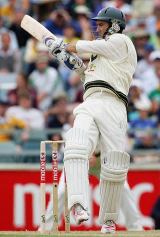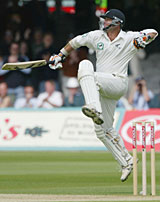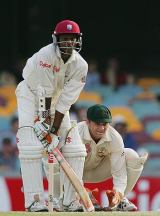
|

Since his promotion to opener in 2001, Justin Langer's game has grown more and more feverish
© Getty Images
|
|
Jacques Rudolph's seven-hour hundred on the last day of the Perth Test was not only one of the great match-saving innings of the last decade; it also showed that, no matter how fast and attack-minded Test cricket becomes, there will always be a place in the game for the old-fashioned grafter or sticker: the batter who scores slowly and is hard to get out.
Yet it must be said that the sticker is a breed of batsman rapidly vanishing from contemporary cricket.
One might proffer this reason or that to explain this, but the fact is inescapable. Batsmen everywhere have learnt to get on with it; on the rare occasions when the going is hard, they usually look to hit their way out of trouble. Even opening batsmen, whose job it traditionally was bat for long periods of time and build a foundation for the strokemakers to follow, now themselves fire away like booming cannons from ball one. Stickers, once feted and valorised for their grit, patience, and skill, just don't carry the same cachet any more in our Strokeful Age.
Yet there remain, dotted across the international cricketing spectrum, a motley band of these reactionaries, men who deal in time as much as runs. And to draw attention to the Sticker Cause, one might form of them a representative cricket XI: six batsmen including an all-rounder, a wicketkeeper, and four bowlers.
Who shall we pick as our openers? We have several options. We might go with Australia's Justin Langer, except that Langer actually ticks along at quite a good clip in Test cricket, and looks a slowcoach only by comparison to some of his rampaging teammates. Indeed, since his promotion to opener in 2001 as partner to the marauding Matthew Hayden, his game has grown more and more feverish. His 191 against Pakistan last year was a masterpiece of attacking batting, and with one stroke - a massive hit over long-on off Mohammad Sami with the second new ball - he took his leave of all the stickers of the world.
So we let Langer go by and look elsewhere, possibly to the doughty Javed Omar, the only Bangladesh batsman who appears so far to have understood that Test cricket is not played in exactly the same way as one-day cricket. Omar has excellent credentials for the job: his strike-rate, at 35.16 per 100 balls, is one of the lowest among contemporary top-order batsmen, though his average is nothing to speak of.

|

In a rare moment of excitment, Mark Richardson celebrates a gritty century at Lords in 2004
© Getty Images
|
|
But the best option of all would be to turn the clock back just a bit, and pluck out from happy retirement a man who was one of the greatest stonewallers ever: New Zealand's Mark Richardson. Richardson, who retired in 2004, started out as a purveyor of slow left-arm spin, suffered the yips in mid-career, took up batting instead, and refashioned himself as an opener of such bloody-mindedness and obduracy as to leave all his competitors in the shade. As S Rajesh points out in this long, worshipful analysis, Richardson averaged a staggering
194 balls of batting per Test; in a universe of stickers, he'd inspire the same awe as a Tendulkar or a Lara.
As partner to Richardson, the claims of Marvan Atapattu of Sri Lanka cannot be ignored. Atapattu's first few innings in Test cricket were like a line of binary code - 0,0,0,1,0, 0 - and, possibly as a result of those early failures, his batting has always had something pensive and reticent about it, as if he's relieved just to be in. Although he has a lot of shots in his arsenal - his cover-driving is particularly sumptuous - he prefers like a good opener to play well within himself. His greatest liability is that he remains a dodgy starter, but once in he really does bed down at the crease: only three players in the history of Test cricket have made more than his six double-hundreds.
Numbers three and four are automatic choices: Rahul Dravid and Jacques Kallis, the two most accomplished batsmen of a primarily defensive, accumulative mindset in the game today - old-fashioned "always look to bat at least a day" men. Some might protest at the inclusion of Dravid, for he is a player of great beauty and artistry; every year he bats more positively and authoritatively than the season before. Yet he is unquestionably a sticker: he puts a higher price on his wicket than anyone in contemporary cricket, possesses a matchless defensive technique, revels in unfavourable batting conditions, and loves playing long innings. One feels that runs are not truly runs for Dravid unless they are tough runs. Kallis has many of the same attributes, plus the additional one of sometimes abruptly becoming becalmed when the situation least demands it - not always in the best interests of his side, but another feather in your cap if you're a sticker. If today you had to pick a pair to bat for your life, it would be those two.

|

Shivnarine Chanderpaul takes stance in his unusual way
© Getty Images
|
|
A week ago we'd have picked at five the current captain of the West Indies, Shivnarine Chanderpaul, the possessor of one of the strangest techniques in Test cricket. Chanderpaul's stance has him almost facing the bowler, his feet pointing down the pitch, although at the point of the bowler's release he walks across his stumps and rights himself somewhat. His crab-like strokes and tenacious air make him a sticker through and through. Yet you will have noted that all of our top four are over thirty and getting a bit long in the tooth, and it's time to back some new talent. Rudolph's innings against Australia shows that he's ready to become the next great sticker, and so we give him the nod over Chanderpaul.
And at six we have a batting Jekyll and Hyde, Pakistan's Abdul Razzaq. Razzaq bats in only two ways, either careeningly fast or stultifyingly slow - his ODI strike-rate is 80.53, and his Test strike-rate 40. Pakistan successfully used him as a one-drop batsman in the 1999 World Cup, when their strategy was to conserve wickets for a slog at the end, and early this year he upturned what appeared to be a lost cause with a match-saving 71 on the last day of the Mohali Test. Razzaq's dour air at the crease also goes in his favour - as Steve Waugh would have let you know, a sticker never smiles, at least not at work.
Onto the wicketkeeper then, and now we have a conundrum on our hands. Most of the wicketkeepers of our time are scorching strokeplayers. Gilchrist, Sangakkara, Boucher, Jones, Akmal, McCullum, Dhoni ...there's no hope to be had in this lot if it's a sticker you're looking for. West Indies's Ridley Jacobs would've been just the man, but he retired last year. We settle finally on another man who recently (and tragically) washed his hands of Test cricket: Zimbabwe's Tatenda Taibu, who as captain of a team full of novices was also his side's best batsman.
Numbers eight, nine, and ten, our lower-order, are easy enough to pick - we just need to look around for the players who usually do service as nightwatchmen. Three outstanding candidates present themselves here: a great legspinner, Anil Kumble; a worthy swing bowler, Matthew Hoggard; and a fine seamer who has only recently fallen out of favour, Jason Gillespie. Indeed, Hoggard has only one shot in his armoury - the forward defensive - and when he cracked Brett Lee through the covers for four to take England to the brink of victory in the Nottingham Test earlier this year, no one appeared as surprised as he himself.

|

Last man out: Glenn McGrath has always show a great desire to hang around
© Getty Images
|
|
One might also consider Shoaib Akhtar, who has recently curbed not only his histrionics and off-field shenanigans but also his batting to boot, and laboured almost a hundred minutes for a patient 38 in the recent Lahore Test. But Shoaib also runs out of patience and launches the ball into the stands every now and then, and we can't have that.
And as last man we must pick a player who's not so much a sticker per se - he wouldn't be a No.11 then - but someone who shows a great desire to hang around, instead of just trundling out for a crossbat heave or two as most jacks do. The undisputed choice here among the No.11s of the world is Glenn McGrath, who under Steve Waugh put in a great deal of work on his batting at one point of time, and who still shakes his head and mutters sorrowfully to himself every time he gets out.
And now find us a nice fresh green pitch, with lots of spots and bumps on it as well for uneven bounce and crazy spin, and bring on any side you will to do battle with our Sticker's XI.
Sticker's XI
1 Mark Richardson, 2 Marvan Atapattu, 3 Rahul Dravid, 4 Jacques Kallis, 5 Jacques Rudolph, 6 Abdul Razzaq, 7 Tatenda Taibu, 8 Anil Kumble, 9 Matthew Hoggard, 10 Jason Gillespie, 11 Glenn McGrath.
Chandrahas Choudhury is a former assistant editor of Wisden Asia Cricket. He also writes the literary blog The Middle Stage



